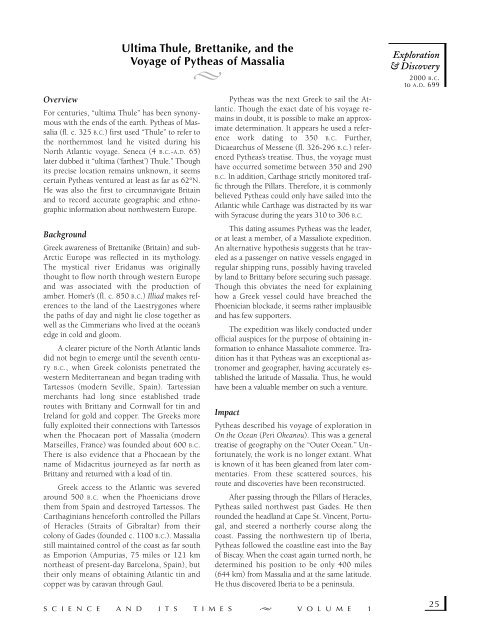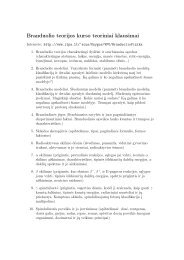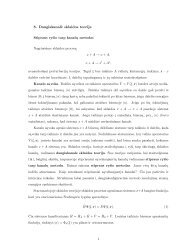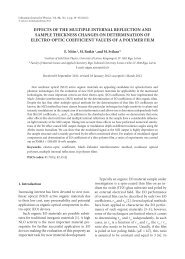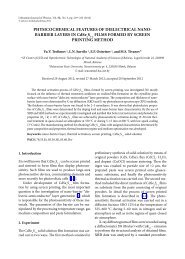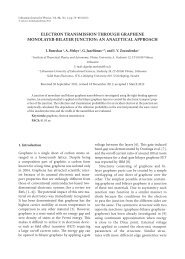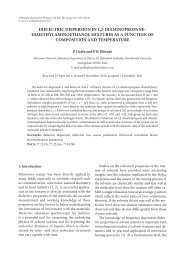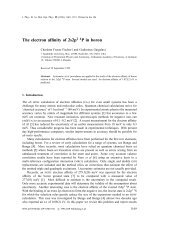Gale - Science and Its Times Vol 01 (2000 BC to AD 699).pdf
Gale - Science and Its Times Vol 01 (2000 BC to AD 699).pdf
Gale - Science and Its Times Vol 01 (2000 BC to AD 699).pdf
You also want an ePaper? Increase the reach of your titles
YUMPU automatically turns print PDFs into web optimized ePapers that Google loves.
Ultima Thule, Brettanike, <strong>and</strong> the<br />
Voyage of Pytheas of Massalia<br />
<br />
Overview<br />
For centuries, “ultima Thule” has been synonymous<br />
with the ends of the earth. Pytheas of Massalia<br />
(fl. c. 325 B.C.) first used “Thule” <strong>to</strong> refer <strong>to</strong><br />
the northernmost l<strong>and</strong> he visited during his<br />
North Atlantic voyage. Seneca (4 B.C.-A.D. 65)<br />
later dubbed it “ultima (‘farthest’) Thule.” Though<br />
its precise location remains unknown, it seems<br />
certain Pytheas ventured at least as far as 62°N.<br />
He was also the first <strong>to</strong> circumnavigate Britain<br />
<strong>and</strong> <strong>to</strong> record accurate geographic <strong>and</strong> ethnographic<br />
information about northwestern Europe.<br />
Background<br />
Greek awareness of Brettanike (Britain) <strong>and</strong> sub-<br />
Arctic Europe was reflected in its mythology.<br />
The mystical river Eridanus was originally<br />
thought <strong>to</strong> flow north through western Europe<br />
<strong>and</strong> was associated with the production of<br />
amber. Homer’s (fl. c. 850 B.C.) Illiad makes references<br />
<strong>to</strong> the l<strong>and</strong> of the Laestrygones where<br />
the paths of day <strong>and</strong> night lie close <strong>to</strong>gether as<br />
well as the Cimmerians who lived at the ocean’s<br />
edge in cold <strong>and</strong> gloom.<br />
A clearer picture of the North Atlantic l<strong>and</strong>s<br />
did not begin <strong>to</strong> emerge until the seventh century<br />
B.C., when Greek colonists penetrated the<br />
western Mediterranean <strong>and</strong> began trading with<br />
Tartessos (modern Seville, Spain). Tartessian<br />
merchants had long since established trade<br />
routes with Brittany <strong>and</strong> Cornwall for tin <strong>and</strong><br />
Irel<strong>and</strong> for gold <strong>and</strong> copper. The Greeks more<br />
fully exploited their connections with Tartessos<br />
when the Phocaean port of Massalia (modern<br />
Marseilles, France) was founded about 600 B.C.<br />
There is also evidence that a Phocaean by the<br />
name of Midacritus journeyed as far north as<br />
Brittany <strong>and</strong> returned with a load of tin.<br />
Greek access <strong>to</strong> the Atlantic was severed<br />
around 500 B.C. when the Phoenicians drove<br />
them from Spain <strong>and</strong> destroyed Tartessos. The<br />
Carthaginians henceforth controlled the Pillars<br />
of Heracles (Straits of Gibraltar) from their<br />
colony of Gades (founded c. 1100 B.C.). Massalia<br />
still maintained control of the coast as far south<br />
as Emporion (Ampurias, 75 miles or 121 km<br />
northeast of present-day Barcelona, Spain), but<br />
their only means of obtaining Atlantic tin <strong>and</strong><br />
copper was by caravan through Gaul.<br />
Pytheas was the next Greek <strong>to</strong> sail the Atlantic.<br />
Though the exact date of his voyage remains<br />
in doubt, it is possible <strong>to</strong> make an approximate<br />
determination. It appears he used a reference<br />
work dating <strong>to</strong> 350 B.C. Further,<br />
Dicaearchus of Messene (fl. 326-296 B.C.) referenced<br />
Pytheas’s treatise. Thus, the voyage must<br />
have occurred sometime between 350 <strong>and</strong> 290<br />
B.C. In addition, Carthage strictly moni<strong>to</strong>red traffic<br />
through the Pillars. Therefore, it is commonly<br />
believed Pytheas could only have sailed in<strong>to</strong> the<br />
Atlantic while Carthage was distracted by its war<br />
with Syracuse during the years 310 <strong>to</strong> 306 B.C.<br />
This dating assumes Pytheas was the leader,<br />
or at least a member, of a Massaliote expedition.<br />
An alternative hypothesis suggests that he traveled<br />
as a passenger on native vessels engaged in<br />
regular shipping runs, possibly having traveled<br />
by l<strong>and</strong> <strong>to</strong> Brittany before securing such passage.<br />
Though this obviates the need for explaining<br />
how a Greek vessel could have breached the<br />
Phoenician blockade, it seems rather implausible<br />
<strong>and</strong> has few supporters.<br />
The expedition was likely conducted under<br />
official auspices for the purpose of obtaining information<br />
<strong>to</strong> enhance Massaliote commerce. Tradition<br />
has it that Pytheas was an exceptional astronomer<br />
<strong>and</strong> geographer, having accurately established<br />
the latitude of Massalia. Thus, he would<br />
have been a valuable member on such a venture.<br />
Impact<br />
Pytheas described his voyage of exploration in<br />
On the Ocean (Peri Okeanou). This was a general<br />
treatise of geography on the “Outer Ocean.” Unfortunately,<br />
the work is no longer extant. What<br />
is known of it has been gleaned from later commentaries.<br />
From these scattered sources, his<br />
route <strong>and</strong> discoveries have been reconstructed.<br />
After passing through the Pillars of Heracles,<br />
Pytheas sailed northwest past Gades. He then<br />
rounded the headl<strong>and</strong> at Cape St. Vincent, Portugal,<br />
<strong>and</strong> steered a northerly course along the<br />
coast. Passing the northwestern tip of Iberia,<br />
Pytheas followed the coastline east in<strong>to</strong> the Bay<br />
of Biscay. When the coast again turned north, he<br />
determined his position <strong>to</strong> be only 400 miles<br />
(644 km) from Massalia <strong>and</strong> at the same latitude.<br />
He thus discovered Iberia <strong>to</strong> be a peninsula.<br />
S C I E N C E A N D I T S T I M E S V O L U M E 1<br />
Exploration<br />
& Discovery<br />
<strong>2000</strong> B.C.<br />
<strong>to</strong> A.D. <strong>699</strong><br />
25


